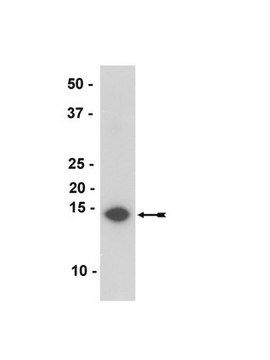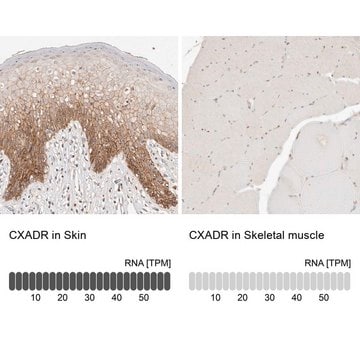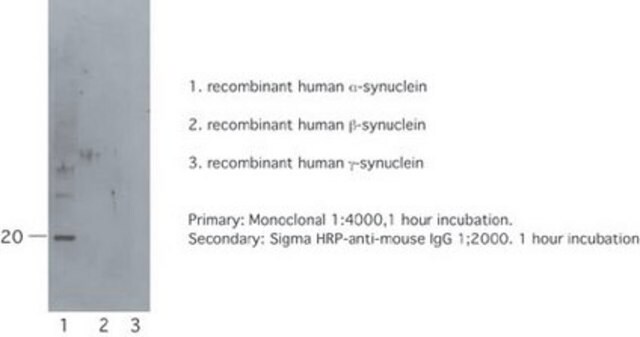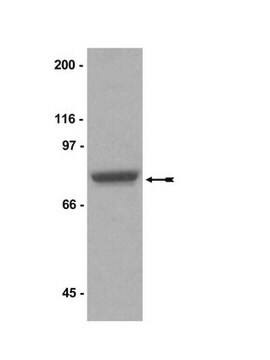MABN1818
Anti-α-Synuclein Antibody, clone SOY1
clone SOY1, from mouse
Synonym(e):
Alpha-synuclein, NACP, Non-A beta component of AD amyloid, Non-A4 component of amyloid precursor, Synuclein alpha-140
About This Item
Empfohlene Produkte
Biologische Quelle
mouse
Qualitätsniveau
Antikörperform
purified immunoglobulin
Antikörper-Produkttyp
primary antibodies
Klon
SOY1, monoclonal
Speziesreaktivität
mouse, human
Speziesreaktivität (Voraussage durch Homologie)
rat (based on 100% sequence homology)
Methode(n)
ELISA: suitable
immunohistochemistry: suitable (paraffin)
immunoprecipitation (IP): suitable
western blot: suitable
Isotyp
IgG2bκ
NCBI-Hinterlegungsnummer
UniProt-Hinterlegungsnummer
Versandbedingung
ambient
Posttranslationale Modifikation Target
unmodified
Angaben zum Gen
human ... SNCA(6622)
Allgemeine Beschreibung
Spezifität
Immunogen
Anwendung
ELISA Analysis: A 1:74.6 dilution from a representative lot (preconjugated with Sulfo tag) detected recombinant human α-synuclein (0.2-40 ng/mL) captured by clone 2F12 (Cat. No. MABN1817; 200 ng/30 µL/well for coating) in a sandwich ELISA application (Courtesy of Tim Bartels, Ph.D., Brigham and Women′s Hospital, Boston, MA, U.S.A.).
Immunoprecipitation Analysis: 4 µL from a representative lot immunoprecipitated α-synuclein from 50 µg of HEL human erythroleukemia cell lysate (Courtesy of Tim Bartels, Ph.D., Brigham and Women′s Hospital, Boston, MA, U.S.A.).
ELISA Analysis: A representative lot (preconjugated with Sulfo tag) detected both endogenous alpha-synuclein (αS) from human cortical homogenate, as well the exogenously expressed wild type and familial PD (fPD) αS mutants (A30P, E46K, H50Q, G51D, A53T) from sytosolic extracts of transfected M17D human neuroblastoma cells in a sandwich ELISA application utilizing clone 2F12 (Cat. No. MABN1817) as the capture antibody (Dettmer, U., et al. (2015). Nat. Commun. 6:7314).
ELISA Analysis: A representative lot (preconjugated with Sulfo tag) detected both pre-aggregated fibrillar recombinant -synuclein as well as partially purified Lewy bodies (LBs) from a DLB (dementia with LBs) patient with or without prior sample denaturing by boiling with 2% SDS in a sandwich ELISA application utilizing clone 2F12 (Cat. No. MABN1817) as the capture antibody (Dettmer, U., et al. (2015). Nat. Commun. 6:7314).
Qualität
Western Blotting Analysis: A 1:125 dilution of this antibody detected α-synuclein in 10 µg of human fetal brain tissue lysate.
Zielbeschreibung
Physikalische Form
Sonstige Hinweise
Sie haben nicht das passende Produkt gefunden?
Probieren Sie unser Produkt-Auswahlhilfe. aus.
Empfehlung
Lagerklassenschlüssel
12 - Non Combustible Liquids
WGK
WGK 1
Flammpunkt (°F)
Not applicable
Flammpunkt (°C)
Not applicable
Analysenzertifikate (COA)
Suchen Sie nach Analysenzertifikate (COA), indem Sie die Lot-/Chargennummer des Produkts eingeben. Lot- und Chargennummern sind auf dem Produktetikett hinter den Wörtern ‘Lot’ oder ‘Batch’ (Lot oder Charge) zu finden.
Besitzen Sie dieses Produkt bereits?
In der Dokumentenbibliothek finden Sie die Dokumentation zu den Produkten, die Sie kürzlich erworben haben.
Unser Team von Wissenschaftlern verfügt über Erfahrung in allen Forschungsbereichen einschließlich Life Science, Materialwissenschaften, chemischer Synthese, Chromatographie, Analytik und vielen mehr..
Setzen Sie sich mit dem technischen Dienst in Verbindung.







